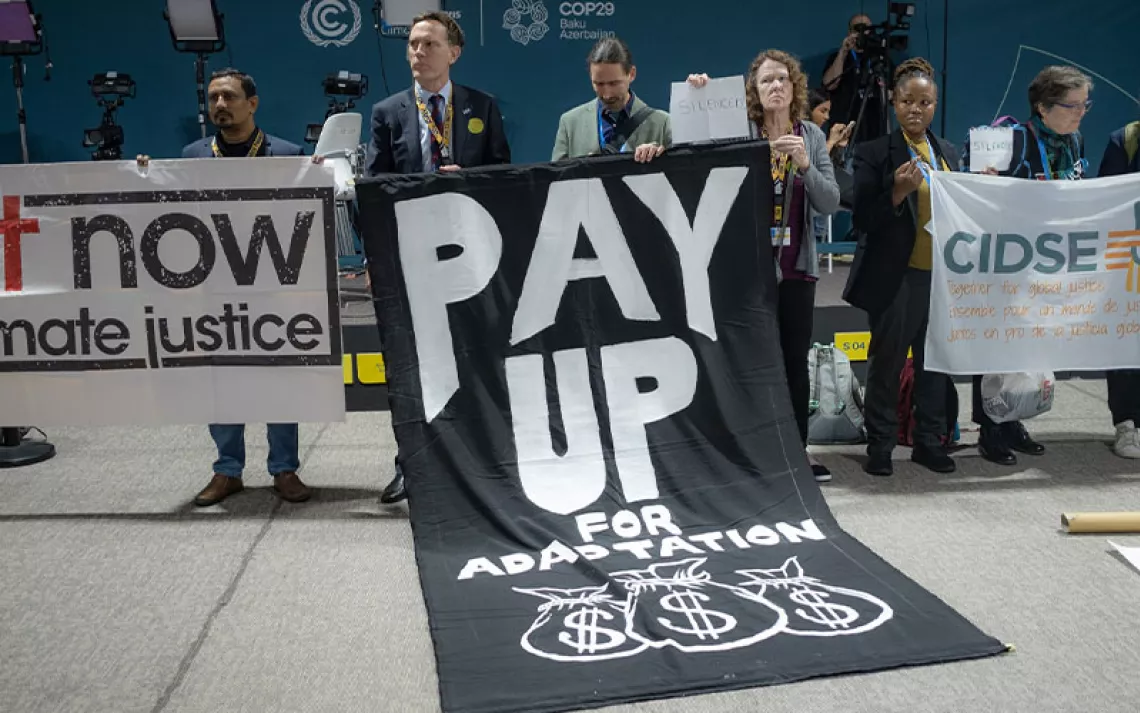Wildlife Contends With Climate Chaos on "Hostile Planet"
Inside the Bear Grylls–hosted nature show for the environmentally "woke"

Hostile Planet displays some of the tropes of wilderness filmmaking—like jaguar versus caiman—but it's not your ordinary nature documentary. | Photo by Adrian Seymour/National Geographic
TELEVISION VIEWERS WHO SEEK OUT nature documentaries for epic panoramas and valiant battles between predator and prey might be in for a bit of a shock when they watch the latest National Geographic Channel series, Hostile Planet.
At first, the six-part series, which premieres in the United States in April, uses some of the classic tropes of wilderness filmmaking. There are epic panoramas of mountains, oceans, deserts, jungles, and grasslands. There are valiant battles among rock star species: jaguar versus caiman, snow leopard versus mountain goat, an eagle duel. Then the plot twists.
Rather than focus on beasts' intra-animal-kingdom strife and the glories of wild nature, the series centers on animals' struggle to live in a world being swiftly transformed by humans. The title⎯Hostile Planet⎯is a giveaway. This isn't the kind of wildlife documentary that celebrates nature as womb and home. Earth, we are told, is an increasingly unforgiving environment where only the strongest will survive.
The second tip that this is a departure from typical nature documentaries? Series host Bear Grylls, the outdoorsman best known for attempting to thrive in inhospitable places as the star of Man vs. Wild. In a stark departure from Sir David Attenborough's measured, wondrous delivery, Grylls infuses the natural world with survivalist swagger. He waxes apocalyptic as animals contend with avalanches, wildfires, extreme temperatures, and other catastrophic weather⎯then mimics their fortitude as he scales barren peaks and paddles wild waters. While Grylls's jovial vibe tempers the brutal realism, the series puts no gloss on grim news. "Animals have had to adapt more in the last 50 years than in the previous 6 million years," director Guillermo Navarro told Sierra, referring to a segment on rockhopper penguins, which have experienced a drastic population reduction as fish stocks have declined. "Every year the stakes of surviving are going to get harder and harder."
Hostile Planet's spectacular and intimate treatment of wildlife rivals that of the blockbuster Blue Planet and the Planet Earth series. Hostile Planet, however, is more impartial, less emotional, than those BBC productions. Devoid of preachy messaging and less reliant on animals' charisma, the series uses statistics and photographic evidence to reveal how human actions are intensifying wildlife conflicts. The show's visual aesthetic also hacks nature doc conventions. Navarro⎯the Oscar-winning cinematographer of Pan's Labyrinth⎯imbues the series with a dark mood to reflect Earth's violent, volatile conditions.
The first episode explores how earlier snowmelt is crowding mountain goats into smaller areas, making it more difficult for them to get sufficient nutrition. The second episode shows hurricanes in Malaysia wreaking such havoc during green turtle mating season that only one in every 10 hatchlings survives.
Hostile Planet is distinctly contemporary, and it's clear that the show's creators geared the program to a younger, more environmentally "woke" audience. "Two and a half years ago, when we started filming, it seemed edgy," producer Tom Hugh-Jones, of Planet Earth II acclaim, told Sierra. "But now it feels untenable to make a wildlife show that doesn't acknowledge the planet's situation."
Despite its candor, Hostile Planet isn't a downer. Its main characters are showcased in dramatic, life-affirming moments⎯crossing ever-widening rivers and overcoming mid-hunt injuries. The majority survive, often in surprising ways. Yet viewers know that they might not get so lucky next season, when Earth may be even less forgiving. Ultimately, the series is a stunning if cautionary celebration of those animals that are managing to cling to the hostile edge of existence⎯for now.
This article appeared in the March/April 2019 edition with the headline "It's Rough Out There."
MORE
Read an interview with Hostile Planet host Bear Grylls: sc.org/grylls.
 The Magazine of The Sierra Club
The Magazine of The Sierra Club



